
HMS Vixen was an armoured composite gunboat, the only ship of her class, and the third ship of the Royal Navy to bear the name. She was the first Royal Navy vessel to have twin propellers.
Nine ships and one shore establishment of the Royal Navy have been named HMS Wasp, with one other government vessel using the name:

HMS Reindeer was a Royal Navy Mariner-class composite screw gunvessel of 8 guns.
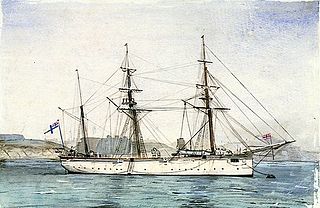
HMS Mariner was the name-ship of the Royal Navy Mariner-class composite screw gunvessel of 8 guns.

HMS Melita was a Royal Navy Mariner-class composite screw sloop of 8 guns, launched in 1888 and commissioned in 1892. She was the only significant Royal Navy warship ever to be built in Malta Dockyard, She was renamed HMS Ringdove in 1915 as a salvage vessel and in 1920 was sold to the Falmouth Docks Company, which changed her name to Ringdove's Aid. She was sold again in 1926 to the Liverpool & Glasgow Salvage Association, renamed Restorer, and finally broken up in 1937, 54 years after her keel was laid.
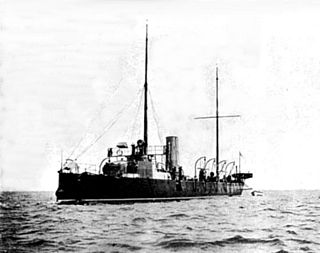
HMS Rattlesnake was a unique design of torpedo gunboat of the Royal Navy. A result of the Russian war scare of 1885, she was designed by Nathaniel Barnaby that year and built by Laird Brothers, of Birkenhead. Quickly made obsolete by the new torpedo boat destroyers, she became an experimental submarine target ship in 1906, and was sold in 1910.

HMS Icarus was a Mariner-class composite screw gunvessel of 8 guns, and the third Royal Navy vessel to carry the name. She was launched in 1885 at Devonport and sold in 1904.
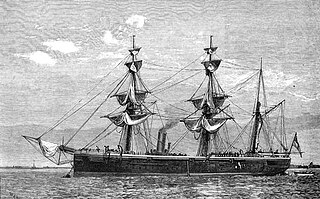
The Doterel class was a Royal Navy class of screw-driven sloops. They were of composite construction, with wooden hulls over an iron frame. They were a revised version of an 1874 design by the Royal Navy's Chief Constructor, William Henry White, the Osprey-class sloop. Two of the class were lost, one to an explosion off Chile and one wrecked off Canada. Gannet is preserved at Chatham Historic Dockyard.
Six ships of the Royal Navy have borne the name HMS Banterer:

HMS Raven was a Banterer-class gunboat of the Royal Navy, built by Samuda Brothers of Poplar, London, and launched on 18 May 1882. She served on the Australia Station and was converted to a diving tender in 1904. After being lent as a training ship in 1913 she was sold for breaking in 1925.
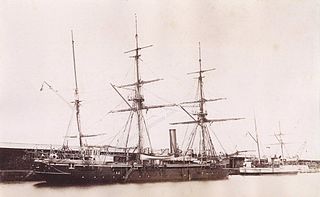
HMS Rambler was an Algerine-class gunvessel of the Royal Navy, built by John Elder & Co., Glasgow and launched on 26 January 1880. She was commissioned as a survey vessel in 1884 and served in Chinese waters during the 1880s and 1890s. She provided men to a naval brigade during the Boer War and was sold on 23 January 1907. The work of this vessel is now remembered in Hong Kong by the Rambler Channel near Tsing Yi.

The Algerine-class gunvessel was a class of three Royal Navy composite gunvessels built in 1880. Two of them were sold after only ten years of service, but the other was converted to a survey ship before commissioning and survived in this role until 1907.
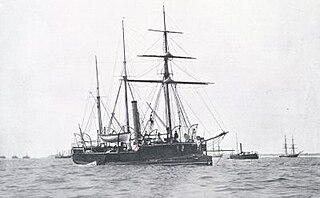
The Medina-class gunboat was a class of 12 Royal Navy Rendel gunboats mounting three 6.3-inch guns, built between 1876 and 1877. Flat-iron gunboats were normally built without masts or rigging, but the Medinas carried a full barquentine rig. Their robust iron hulls meant that they lingered on as diving tenders, barges and lighters, with five of them working into the 1920s. The hull of Medway lies in shallow water in Bermuda and is visible on satellite imagery.
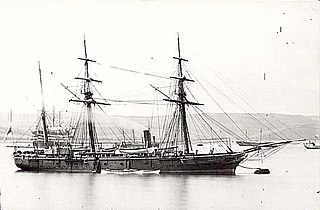
The Arab-class gunvessels were a pair of composite gunboats built for the Royal Navy in the mid-1870s.

The Banterer-class gunboat was a class of eleven gunboats mounting two 6-inch and two 4-inch guns, built for the Royal Navy between 1880 and 1892.

The Albacore-class gunboat, also known as "Crimean gunboat", was a class of 98 gunboats built for the Royal Navy in 1855 and 1856 for use in the 1853-1856 Crimean War. The design of the class, by W. H. Walker, was approved on 18 April 1855. The first vessels were ordered the same day, and 48 were on order by July; a second batch, which included Surly, were ordered in early October.

The Bramble-class gunboat was a class of four gunboats mounting six 4-inch guns, built for the Royal Navy in 1886. In 1887 the first three were reclassified as gunvessels.

The Forester-class gunboat was a class of 4-gun composite gunboats built for the Royal Navy between 1874 and 1877. Although half had been sold by 1890, the rest survived into the 20th century as coal hulks, base vessels and other secondary uses. Foxhound survived as a hulk on the Blackwall Reach of the Thames until 1975, when she was broken up. They were built of composite construction, that is, with iron keel, stem and stern posts, and iron framing, but planked with wood.

The Albacore-class gunboat was a class of three gunboats built for the Royal Navy in 1883. The name had already been used for a class of 98 gunboats built during the Great Armament of the Crimean War.
















